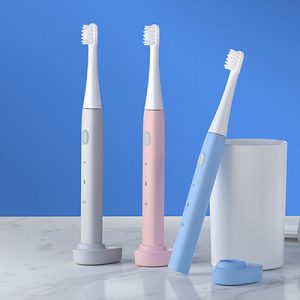The operation of Pap brushing method:
1. Correct grip, with thumbs extending forward more than the “like” gesture.
2. Align the toothbrush at the place where the teeth and the gums meet, and when brushing the upper teeth, the bristles face upwards as shown in the figure (when brushing the upper row of teeth, the bristles face upwards, covering a little gum, and the toothbrush moves horizontally for a short distance.) (brushing the lower row of teeth) When the teeth are bristles facing down, brush in the same way.)
3. The bristles and the teeth are at an angle of 45-60 degrees. At the same time, gently press the bristles toward the teeth to make the bristles slightly arc, and the sides of the bristles also have considerable contact with the teeth. (The toothbrush is at an angle of 45 to 60 degrees with the teeth, and lightly press against the teeth, so that the sides of the bristles are also in contact with the teeth, but the bristles must not be branched by the teeth.)
4. After the toothbrush is positioned, start a short horizontal movement, brushing the two or three teeth back and forth about ten times.
5. Open your mouth when brushing your teeth and see the last tooth on the right side of the upper row. Then start from the right back cheek side and brush to the left; then the left occlusal surface, the left lingual side and then back to the right lingual side, and then the right occlusal surface. There will be no omissions in such a sequential brushing. (The sequence of brushing your teeth has a formula: start on the right and end on the right.)
6. When brushing the occlusal surface, brush two or two teeth back and forth.
7. The lingual side of the posterior teeth of the upper jaw is less easy to brush. The bristles are still aligned with the junction of the teeth and the gums, and the handle should be close to the front teeth.
When brushing the right lingual side, the handle will naturally face to the left. At this time, we recommend using the left hand to brush the lingual side of the right posterior teeth.
8. In addition, brush the buccal side of the back teeth with the same hand, that is, brush the right buccal side with the right hand. Use your left hand on the left cheek side. At the same time, the handle of the brush can prop up the cheeks to facilitate sight. )
9. After brushing the upper teeth, use the same principles and methods to brush the lower teeth.
1. Bass method of brushing teeth
1. Brush the gingival margin of the neck
(1) Hold the brush handle and place the brush head on the neck of the tooth. The bristles are at a 45° angle to the long axis of the tooth, and the bristles point to the root of the tooth (upper teeth are up and lower teeth are down), and light pressure is applied to make the bristles enter the gums. Groove, partly on the gingival margin.
(2) With 2~3 teeth as a group, shake the toothbrush horizontally at a short distance (approximately 2mm) 4~6 times. Then turn the toothbrush toward the crown of the tooth to brush the lip and tongue (palatal) surface. Pay attention to gentle movements.
(3) Move the toothbrush to the next set of 2~3 teeth and reposition it. Pay attention to the overlapping of 1~2 teeth.
(4) When brushing the lingual (palatal) surface of the anterior teeth, put the brush head on the tooth surface so that the front bristles touch the gingival margin or enter the gingival sulcus. Brush back and forth. When brushing the lingual surface of the front teeth, brush from bottom to top.
2. Brush the cheek-lingual (palatal) surface with a brushing method. Perform between (2) and (3) steps to maintain a consistent brushing action. Brush each part of the upper and lower jaw arches, lip, tongue, and palate in order. Don’t miss out.
3. Brush the occlusal surface. Hold the handle with the bristles pointing to the occlusal surface. Use a little force to brush back and forth. Note that the upper, lower, left, and right sections must be brushed.
2. Brushing time and frequency
In order to ensure that each tooth surface has enough brushing time, each brushing time is not less than three minutes. In order to control dental plaque, maintain oral hygiene and fresh breath, brush your teeth at least once a day in the morning and evening.








